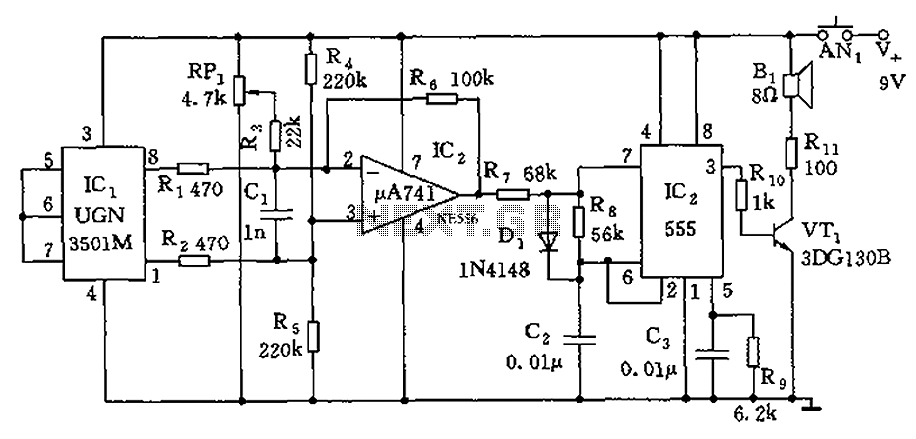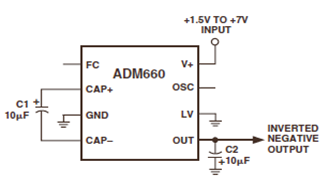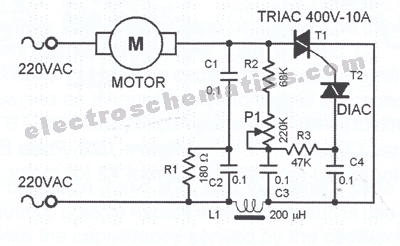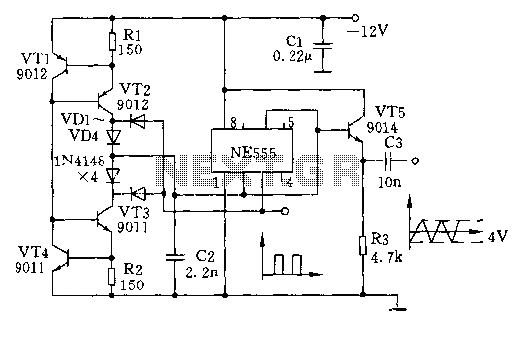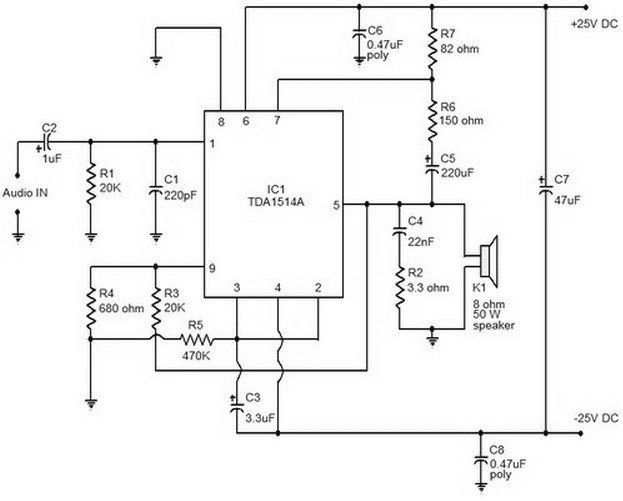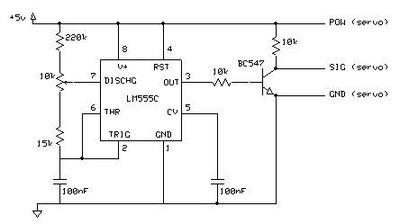
A New Solar / Wind Charge Controller Based on the 555 Chip
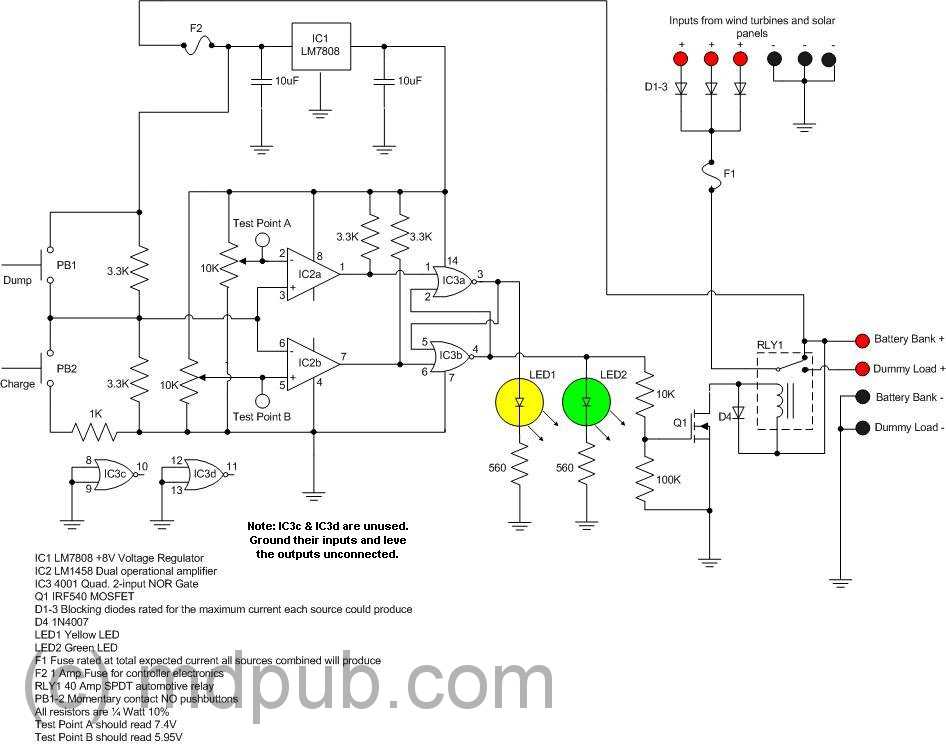
The prototype was successfully assembled on a breadboard and subsequently built on a piece of Radio Shack protoboard for field use. The assembly process took only a couple of hours, and it functioned correctly on the first attempt. This more robust version will be enclosed in a box and subjected to thorough field testing. The design utilizes the 78L05 version of the 5V regulator, which is housed in a compact TO-92 package, similar in size to the 2N2222 transistor. This choice conserves board space. Although it can only handle 100 mA, this is sufficient for the circuit's needs. If the 78L05 is unavailable, the larger TO-220 version of the 7805 can be used without significant drawbacks, aside from occupying more board space. Calibration of the circuit is necessary after assembly. The low and high set points for the controller are set at 11.9V and 14.9V, respectively. These points define the transition between supplying power to the batteries and diverting power to a dummy load. The dummy load is only required for wind turbine applications; for solar panels, this line can remain open. To tune the circuit, a variable DC power supply should be connected to the battery terminals. Setting the power supply to 11.9V allows for measurement at Test Point 1, where R1 should be adjusted until the voltage reaches approximately 1.667V. Next, set the power supply to 14.9V and measure at Test Point 2, adjusting R2 until the voltage is close to 3.333V. The charge controller's operation can be tested by varying the input voltage between 11.7V and 15.1V. The relay should engage around 14.9V and disengage at approximately 11.9V, maintaining its state in between set points. The Charge and Dump buttons allow for manual state changes when the input voltage is within the specified range. Despite concerns regarding the lower set point potentially over-discharging the batteries, it is noted that the battery voltage typically does not drop that low under normal conditions. When the load is removed, the voltage tends to recover above 12V over time. After confirming the circuit's functionality, it was enclosed in a semi-weatherproof case. The relay is positioned on the left side, and a barrier strip is used for simplified wiring. Heavy gauge wire is employed for high-current connections, as the device is designed to switch up to 40 Amps. A fuse is included in the solar/wind input line. The enclosure was chosen based on availability rather than optimal suitability. For long-term outdoor use, a more durable and weatherproof enclosure would be preferable. However, the translucent lid allows for visibility of the LEDs, indicating the charge controller's state without additional modifications. This enclosure is adequate for field testing. A side view of the unit reveals the feed-through barrier strip with external connections, including the positive terminal for the battery(s), the positive input from a solar panel or wind turbine, an optional dummy load connection, and three ground connections. It is recommended to connect the battery first to ensure a stable power source for the electronics.
The circuit design centers around a charge controller that effectively manages power distribution between battery storage and load applications, particularly for renewable energy sources like solar panels and wind turbines. The use of the 78L05 voltage regulator ensures that the circuit receives a stable 5V supply, critical for the reliable operation of control electronics. The choice of components, including the use of a relay, allows for high-current switching, accommodating loads up to 40 Amps, which is essential for applications involving significant power draw.
The calibration process is crucial for ensuring that the controller operates correctly within the defined voltage thresholds. By adjusting resistors R1 and R2, the circuit can be fine-tuned to switch accurately between charging the batteries and diverting excess energy to a dummy load. This capability is particularly important for optimizing battery life and performance, as it prevents over-discharging and ensures that batteries are charged efficiently.
The enclosure design, while not ideal for permanent outdoor installation, provides adequate protection during field testing. The use of a barrier strip simplifies connections and enhances the overall reliability of the system by reducing the risk of loose or faulty connections. The inclusion of a fuse adds an additional layer of safety, protecting the circuit from potential overcurrent situations.
Overall, this charge controller design exemplifies a practical approach to managing renewable energy sources, emphasizing both functionality and ease of use in field applications.I had the prototype working on the breadboard, I built another unit on a piece of Radio Shack Protoboard for use in the field. It came together in only a couple of hours, and again, worked the first time (I must be living right lately).
This more rugged version will get mounted in a box and given a thorough testing in the field. Note that onthis board I have chosen to use the 78L05 version of the 5 Volt regulator. It is in a tiny TO-92 package, the same size as the 2N2222 transistor. It is the small, black rectangle on the upper left corner of the board. It saves a lot of board space. It can only handle 100 mA, but that is plenty enough to power this circuit. If you can`t find the little 78L05, you can use the full size TO-220 version of the 7805, which is much more common. There will be no penalty other than using up a little more board real estate. I just happened to have a few of the 78L05s left over from another project. Once you have the circuit built, it is time to tune or calibrate it. I use 11. 9V and 14. 9V as my low and high set points for the controller. These are the points where it switches from sending power to the batteries to dumping power into a dummy load, and vice versa (a dummy load is only needed if you are using a wind turbine, if using only solar panels, the dummy load line can be left open).
Probably the best way to tune the circuit is to attach a variable DC power supply to the battery terminals. Set the power supply to 11. 9V. Measure the voltage at Test Point 1. Adjust R1 until the voltage at the test point is as close to 1. 667V as you can get it. Now set your variable power supply to 14. 9V and measure the voltage at Test Point 2. Adjust R2 until the voltage at the test point is as close to 3. 333V as you can get it. Test the operation of the charge controller by running the input voltage up and down between about 11.
7 and 15. 1 Volts. You should hear the relay pull in at about 14. 9 Volts and open at about 11. 9 Volts. In between the two set points the controller should stay in whichever state it is in. The Charge and Dump buttons can be used to change the state of the controller when the input Voltage is between the two set points. Before you write to me and tell me that my lower set point is too low and I am over-discharging my batteries, consider that the battery voltage isn`t normally going to get that low except under load.
If the load were removed, the voltage would recover over time back up to well over 12V. So the batteries aren`t as deeply discharged as you might think at first glance. Once I had the circuit working, I mounted it inside a semi-weatherproof enclosure. The relay is on the left side. I used a barrier strip to make wiring everything together easier. I used heavy gage wire for all the high-current connections. This thing was designed to switch up to 40 Amps after all. I also included a fuse in line with the solar/wind input line. Here is another view with the lid in place. I used this enclosure because I happened to already have it on hand, not because it is the best one for the job. For permanent outdoor use I would prefer to use a more rugged and weather-proof enclosure like I did for my original charge controller design.
However, I like the fact that I can see the LEDs through the translucent lid and tell which state the charge controller is in at a glance, and I didn`t have to drill any extra holes in the box for the LEDs. This box will work for field testing purposes. Here is a side view of the unit showing the feed-through barrier strip with all the connections to the outside.
There are connections for the positive side of the battery(s), the positive input from a solar panel or wind turbine, the positive side of an optional dummy load, and three ground connections. When hooking up the charge controller, the battery should be connected first. That way the electronics will have a stable source of power 🔗 External reference
The circuit design centers around a charge controller that effectively manages power distribution between battery storage and load applications, particularly for renewable energy sources like solar panels and wind turbines. The use of the 78L05 voltage regulator ensures that the circuit receives a stable 5V supply, critical for the reliable operation of control electronics. The choice of components, including the use of a relay, allows for high-current switching, accommodating loads up to 40 Amps, which is essential for applications involving significant power draw.
The calibration process is crucial for ensuring that the controller operates correctly within the defined voltage thresholds. By adjusting resistors R1 and R2, the circuit can be fine-tuned to switch accurately between charging the batteries and diverting excess energy to a dummy load. This capability is particularly important for optimizing battery life and performance, as it prevents over-discharging and ensures that batteries are charged efficiently.
The enclosure design, while not ideal for permanent outdoor installation, provides adequate protection during field testing. The use of a barrier strip simplifies connections and enhances the overall reliability of the system by reducing the risk of loose or faulty connections. The inclusion of a fuse adds an additional layer of safety, protecting the circuit from potential overcurrent situations.
Overall, this charge controller design exemplifies a practical approach to managing renewable energy sources, emphasizing both functionality and ease of use in field applications.I had the prototype working on the breadboard, I built another unit on a piece of Radio Shack Protoboard for use in the field. It came together in only a couple of hours, and again, worked the first time (I must be living right lately).
This more rugged version will get mounted in a box and given a thorough testing in the field. Note that onthis board I have chosen to use the 78L05 version of the 5 Volt regulator. It is in a tiny TO-92 package, the same size as the 2N2222 transistor. It is the small, black rectangle on the upper left corner of the board. It saves a lot of board space. It can only handle 100 mA, but that is plenty enough to power this circuit. If you can`t find the little 78L05, you can use the full size TO-220 version of the 7805, which is much more common. There will be no penalty other than using up a little more board real estate. I just happened to have a few of the 78L05s left over from another project. Once you have the circuit built, it is time to tune or calibrate it. I use 11. 9V and 14. 9V as my low and high set points for the controller. These are the points where it switches from sending power to the batteries to dumping power into a dummy load, and vice versa (a dummy load is only needed if you are using a wind turbine, if using only solar panels, the dummy load line can be left open).
Probably the best way to tune the circuit is to attach a variable DC power supply to the battery terminals. Set the power supply to 11. 9V. Measure the voltage at Test Point 1. Adjust R1 until the voltage at the test point is as close to 1. 667V as you can get it. Now set your variable power supply to 14. 9V and measure the voltage at Test Point 2. Adjust R2 until the voltage at the test point is as close to 3. 333V as you can get it. Test the operation of the charge controller by running the input voltage up and down between about 11.
7 and 15. 1 Volts. You should hear the relay pull in at about 14. 9 Volts and open at about 11. 9 Volts. In between the two set points the controller should stay in whichever state it is in. The Charge and Dump buttons can be used to change the state of the controller when the input Voltage is between the two set points. Before you write to me and tell me that my lower set point is too low and I am over-discharging my batteries, consider that the battery voltage isn`t normally going to get that low except under load.
If the load were removed, the voltage would recover over time back up to well over 12V. So the batteries aren`t as deeply discharged as you might think at first glance. Once I had the circuit working, I mounted it inside a semi-weatherproof enclosure. The relay is on the left side. I used a barrier strip to make wiring everything together easier. I used heavy gage wire for all the high-current connections. This thing was designed to switch up to 40 Amps after all. I also included a fuse in line with the solar/wind input line. Here is another view with the lid in place. I used this enclosure because I happened to already have it on hand, not because it is the best one for the job. For permanent outdoor use I would prefer to use a more rugged and weather-proof enclosure like I did for my original charge controller design.
However, I like the fact that I can see the LEDs through the translucent lid and tell which state the charge controller is in at a glance, and I didn`t have to drill any extra holes in the box for the LEDs. This box will work for field testing purposes. Here is a side view of the unit showing the feed-through barrier strip with all the connections to the outside.
There are connections for the positive side of the battery(s), the positive input from a solar panel or wind turbine, the positive side of an optional dummy load, and three ground connections. When hooking up the charge controller, the battery should be connected first. That way the electronics will have a stable source of power 🔗 External reference
